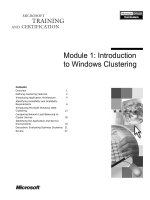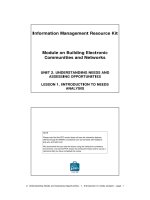Chapter 1: Introduction to language testing doc
Bạn đang xem bản rút gọn của tài liệu. Xem và tải ngay bản đầy đủ của tài liệu tại đây (55.85 KB, 10 trang )
Chapter 1:
Introduction to language testing
Source: Heaton, J.B. (1989).
Writing English Language Tests
.
Longman & New York
1. Testing & teaching
Testing & Teaching: closely related
Tests:
- devices to reinforce learning & motivate Ss
- means of assessing Ss’ lang. performance
Tests focusing on daily communication
useful effects on learning
Good communicative tests+ effects:
learning, teaching & learning habits
2. Why test?
Evaluating Ss’ performance (comp. &
selecting)
Locating the precise area of Ss’ difficulty
Ascertaining difficult problems in curriculum
Measuring Ss’ performance w/o traps
effective motivation
3. What should be tested & to
what standard?
Analyzing the language tested: important
Identifying the purpose of assessment:
including aspects /skills tested
Before constructing tests: to questions
standards
4. Testing the language skills
Listening: short utterances, dialogues, talks
& lectures
Speaking: interview, picture description, role
play, problem-solving tasks (pair/group)
Reading: ability to understand gist, key
information on specific points
Writing: letters, reports, messages……
5. Testing language areas
Grammar & usage: measuring Ss’ ability to
recognize appro. gram forms & to
manipulate structures
Vocabulary: meaning, pattern, collocations
Phonology: stress patterns,
tunes (↑↓voice)
6. Language skills & language
elements
Skills, integrated skills, elements: purpose of
tests & level of learners
All levels: measuring ability to communicate
A good lang. test: Ss’ performance in 4 skills
used in real life
7. Recognition & production
Recognition: words & language form-
multiple-choice forms (easy to examine
statistically)
Production: measuring learners’ ability to
produce or use correct lang. forms in real life
A good language test: either recognition or
production items, or combination of both
8. Problems of sampling
The longer the test the more reliable a
measuring instrument
The language tested= the one used in the
classroom
Items based on contrastive analysis:
effective for Ss from the same L1
Writing test specifications based on learning
tasks included in the syllabus
9. Avoiding traps for the Ss
Never trap Ss in giving incorrect answers
Not including items never taught
Finding out what Ss know, not trapping them
Gaining a deeper insight the language tested
& learning process involved









